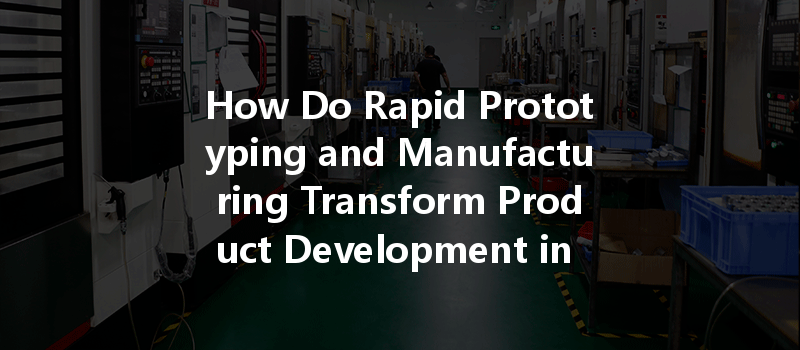In an era where speed and efficiency reign supreme, businesses across various sectors are feeling the pressure to innovate faster than ever before. Traditional manufacturing processes, often cumbersome and time-consuming, are giving way to more agile methodologies. Among these, rapid prototyping and manufacturing stand out as game-changers. Companies like YL Machining are leading the charge in revolutionizing how products are developed, tested, and brought to market. This article takes a deep dive into the world of rapid prototyping and manufacturing, exploring its significance, the ways it enhances product development, and how YL Machining is at the forefront of this innovation.
Understanding Rapid Prototyping and Manufacturing
What is Rapid Prototyping?
Rapid prototyping encompasses various manufacturing techniques aimed at quickly creating prototype models from 3D CAD data. It allows designers and engineers to fast-track the development of their ideas by producing tangible models to evaluate, test, and refine. This not only shortens the product development cycle but also significantly reduces costs associated with traditional prototyping methods.
Why is Prototyping Important?
Prototyping plays a critical role in the design process. It enables companies to:
The Role of Manufacturing in Rapid Prototyping
Manufacturing complements rapid prototyping by providing the means to produce prototypes quickly and efficiently. Techniques such as CNC machining, 3D printing, and injection molding are often employed, depending on the project’s requirements.
How Rapid Prototyping Accelerates Product Development
Enhanced Collaboration Between Teams
Rapid prototyping fosters continuous collaboration between engineers, designers, and other stakeholders. At YL Machining, we emphasize a collaborative environment where ideas can be exchanged fluidly. This collective approach results in better design outcomes and ensures everyone is on the same page regarding project goals.
Iterative Design Process
One significant advantage of rapid prototyping is its iterative nature. Unlike traditional methods that may take weeks or months to create a prototype, rapid prototyping can produce prototypes in mere hours or days. This allows teams to cycle through design iterations quickly, making necessary adjustments based on testing and feedback without significant delays.
Cost-Effectiveness
Investing in rapid prototyping can dramatically reduce development costs. Traditional manufacturing typically involves high upfront costs for tooling and setup, but rapid prototyping minimizes these expenses. At YL Machining, our state-of-the-art equipment allows for low-volume production runs without the prohibitive costs associated with large-scale manufacturing.
Speed to Market
With rapid prototyping, the time it takes to bring a product from concept to market is significantly reduced. Companies can test their products in real-world scenarios sooner, gain insights from the marketplace, and make timely adjustments based on consumer behavior. This speed can be a considerable competitive advantage.

Risk Mitigation
The versatility of rapid prototyping also helps mitigate risks. By validating designs early on, companies can avoid investing in flawed concepts that won’t succeed in the market. YL Machining’s approach includes a robust quality assurance process to ensure any prototype produced is viable and ready for testing.
YL Machining’s Innovative Approach to Rapid Prototyping and Manufacturing
Advanced Technology and Techniques
At YL Machining, we are proud of our investment in the latest technologies that keep us at the forefront of rapid prototyping. We employ a range of techniques:
Customized Solutions
Every project is unique, and at YL Machining, we pride ourselves on offering tailored solutions. Our team collaborates closely with clients to understand their specific requirements, ensuring that prototypes meet functional and aesthetic needs. With our array of manufacturing methodologies, we can adapt to different industries ranging from automotive to medical devices, and beyond.
Sustainability Initiatives
In today’s world, sustainability is more than a buzzword; it’s a necessity. At YL Machining, we are committed to environmentally friendly practices. Our rapid prototyping processes minimize waste and energy consumption, contributing to a more sustainable manufacturing ecosystem. By adopting recyclable materials wherever possible, we are not just enhancing our immediate environment; we’re also meeting the increasing consumer demand for sustainable products.
The Future of Rapid Prototyping and Manufacturing
Integration with AI and Automation
As technologies evolve, so does the potential of rapid prototyping and manufacturing. One area of rapid growth is the integration of artificial intelligence (AI) and automation. By leveraging AI algorithms, YL Machining can optimize design processes, predict failures, and automate sequence operations, further shortening lead times and enhancing quality.
The Rise of Digital Twins
Another significant advancement is the concept of digital twins—virtual replicas of physical systems. This technology allows companies to simulate real-world performance through prototypes before manufacturing them. The use of digital twins can lead to better-informed decisions, thereby increasing the likelihood of a successful product launch.
Personalized Manufacturing
The future of product development is heading towards personalization. Rapid prototyping will facilitate more customized products, allowing companies to cater to individual consumer preferences. This trend could redefine entire industries, from fashion to health care, guiding YL Machining’s evolution in servicing our clients’ needs.
The landscape of manufacturing is evolving, and rapid prototyping stands at the forefront of this transformation. Companies like YL Machining are redefining the boundaries of what’s possible, driving innovation, and shortening the path from concept to production. The agility, efficiency, and cost-effectiveness afforded by rapid prototyping not only enhance product development but also empower businesses to meet the fast-paced demands of the modern market.
As we move forward, it’s essential for companies to embrace these methodologies and invest in new technologies that allow for agile, consumer-centric product development. The future is bright, and for those who dare to innovate, opportunities are boundless. Will you be ready to leap into the future with us?






